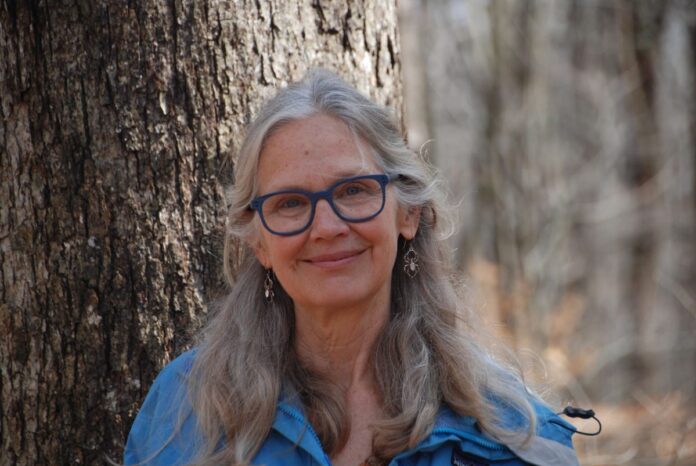By LESLIE BISHOP, guest columnist
The leaves are down, the colors are fading, and once again our landscape changes.
As I walk in the woods these late November days, I shuffle my feet through leaves in rich shades of brown. I look up to towering trees, the dark textures of their bark punctuated by the soft gray sky. The brown landscape is peppered with the occasional emerald green of the Christmas fern that keeps its color all year.
But when I pay attention, when I shift my gaze from up to down, and when I lean in to look closely, I also see multiple shades of green — the greens of moss.
I see layers of moss on rocks, patches of moss on tree bases and logs, and soft cushions of moss on the soil. And when I get down on my hands and knees for a closer look, the green patches reveal a diversity of moss growth patterns, colors and textures.
[sc:text-divider text-divider-title=”Story continues below gallery” ]Some resemble tiny ferns, some minute pine trees, and others plush carpets. Mosses form miniature green forests waiting to be explored, and they are available any time of year.
These minute moss forests provide habitat for numerous, even smaller organisms. A look at a clump of moss under the microscope can bring as much delight as a drop of pond water. Robin Wall Kimmerer notes that “one gram of moss from the forest floor, a piece the size of a muffin, would harbor 150,000 protozoa, 132,000 tardigrades, 3,000 springtails, 800 rotifers, 500 nematodes, 400 mites, and 200 fly larvae” (from “Gathering Moss, A Natural and Cultural History of Mosses”).
One of my favorite activities when teaching biology is to have the students search for tardigrades, also called “water bears” because of their comical bear-like shape, as the tiny animals lumber over a moss leaf. These miniature worlds can open us to a different perspective and a new sense of wonder about the diversity of life on Earth.
Mosses belong to a group of plants called bryophytes that also includes liverworts and hornworts. The bryophytes of today are modern relatives of the earliest land plants that evolved 500 to 630 million years ago. Their ancient lineage is reflected in their physiology.
They are all very small plants, so small that their leaves are only one cell thick. They are characterized by having no xylem or phloem (the circulatory tissue of vascular plants that transports water and food). They absorb nutrients and water through their surfaces and have simplified conducting tissues, and thus they are confined to moist environments.
Their simplicity has not deterred their success; there are more than 22,000 species of bryophytes living in a diversity of ecosystems all over the world.
Different species of moss thrive on different substrates. Some can be the first plants to colonize a newly created habitat, such as after a volcanic eruption. The tiny plants can attach and grow on bare rock, and their biological activities help break the rock down to soil that is then usable for other types of plants.
Others prefer the base of trees, where they receive the drips of moisture channeled in tiny streams by the textures of tree bark.
Others choose the crumbling surface of a rotting log, where they become part of the forest’s mechanism of recycling nutrients.
Others grow on bare soil, where they form thick mats that hold the soil in place, prevent erosion, and act as a filters to purify groundwater.
The life cycle of mosses is an elegant example of alternation of generations, when an individual moss alternates between a haploid form and a diploid form.
The green plant we notice on a log is the haploid gametophyte that produces eggs and sperm. After fertilization, a brown stalk-like diploid sporophyte emerges from the gametophyte to produce haploid spores. Spores explode from the sporophyte capsule when ripe and germinate to produce new gametophytes (new moss plants).
You could fill a watercolor palette with the shades of green found in mosses. Some mosses are a silvery pale green, some a rustic golden brown, some a soft blue-green, and yet others deep forest green. They all provide splashes of verdant color on the late fall and winter forest landscape.
Mosses invite us to shift our perspective to look closer and to explore their miniature world.
Leslie Bishop is a Brown County resident and retired biology professor from Earlham College. She is a volunteer interpretive naturalist at Brown County State Park. She can be reached through the newspaper at [email protected].





